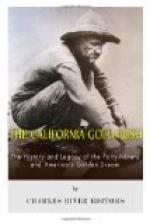The Bear Flag Revolution took place on June 14,1846. On July 7 the American flag was hoisted over the post at Monterey by Commodore Sloat. Though he had knowledge from June 5 of a state of war, this knowledge, apparently, he had shared neither with his officers nor with the public, and he exhibited a want of initiative and vigor which is in striking contrast to Fremont’s ambition and overzeal.
Shortly after this incident Commodore Sloat was allowed to return “by reason of ill health,” as has been heretofore published in most histories. His undoubted recall gave room to Commodore Robert Stockton, to whom Sloat not only turned over the command of the naval forces, but whom he also directed to “assume command of the forces and operations on shore.”
Stockton at once invited Fremont to enlist under his command, and the invitation was accepted. The entire forces moved south by sea and land for the purpose of subduing southern California. This end was temporarily accomplished with almost ridiculous ease. At this distance of time, allowing all obvious explanations of lack of training, meager equipment, and internal dissension, we find it a little difficult to understand why the Californians did not make a better stand. Most of the so-called battles were a sort of opera bouffe. Californians entrenched with cannon were driven contemptuously forth, without casualties, by a very few men. For example, a lieutenant and nine men were sufficient to hold Santa Barbara in subjection. Indeed, the conquest was too easy, for, lulled into false security, Stockton departed, leaving as he supposed sufficient men to hold the country. The Californians managed to get some coherence into their councils, attacked the Americans, and drove them forth from their garrisons.
Stockton and Fremont immediately started south. In the meantime an overland party under General Kearny had been dispatched from the East. His instructions were rather broad. He was to take in such small sections of the country as New Mexico and Arizona, leaving sufficient garrisons on his way to California. As a result, though his command at first numbered 1657 men, he arrived in the latter state with only about 100. From Warner’s Ranch in the mountains he sent word to Stockton that he had arrived. Gillespie, whom the Commodore at once dispatched with thirty-nine men to meet and conduct him to San Diego, joined Kearny near San Luis Rey Mission.
A force of Californians, however, under command of one Andres Pico had been hovering about the hills watching the Americans. It was decided to attack this force. Twenty men were detailed under Captain Johnston for the purpose. At dawn on the morning of the 6th of December the Americans charged upon the Californian camp. The Californians promptly decamped after having delivered a volley which resulted in killing Johnston. The Americans at once pursued them hotly, became much scattered, and were turned




